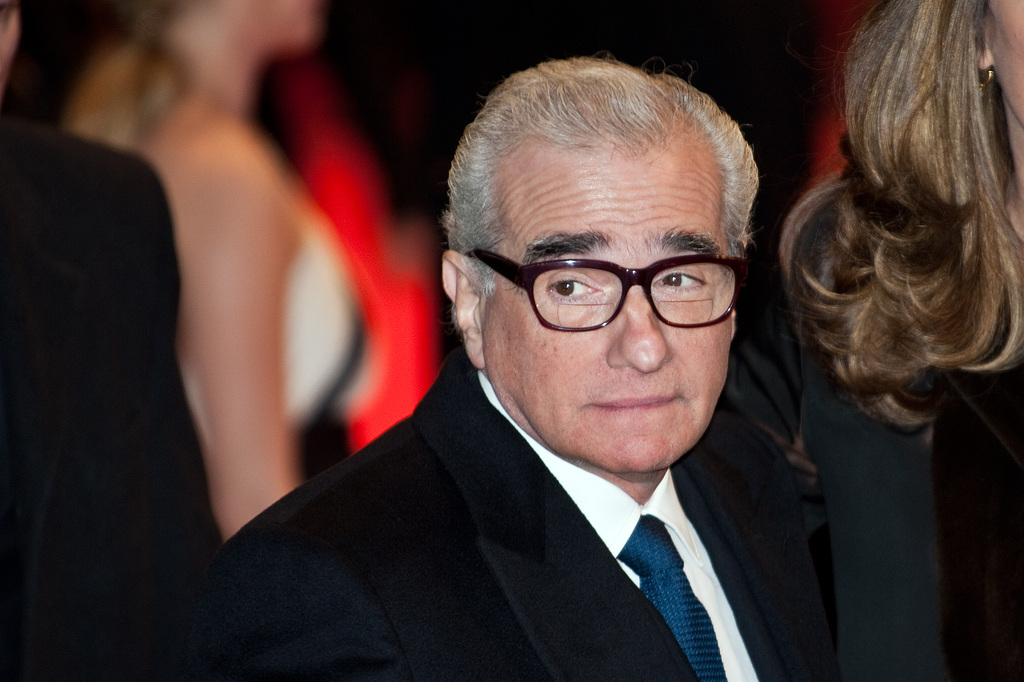“I never waited for anyone who was late more than ten minutes in my life,” says Jimmy Hoffa to his former partner Anthony “Tony Pro” Provenzano. Provenzano is fifteen (count ‘em, fifteen!) minutes late to this particular meeting, intended to settle some bad blood between the two men. “Pro” protests that Hoffa should extend his limit to fifteen minutes, because, “You gotta account for the traffic,” but Hoffa sees right through his oversized sunglasses: “Ten minutes, you got stuck in traffic. Fifteen minutes – you’re saying something.”
This scene, deep in the second hour of Martin Scorsese’s three-and-a-half-hour opus, The Irishman, can be read as just a wink at the audience, like De Niro’s earlier narration of the necessity of going to the bathroom before doing a hit. Much has been made of this film’s oversized runtime, as yet the longest in Scorsese’s career. Three hours is just three super-sized acts. Three and a half hours – you’re saying something. Ever since Raging Bull, Scorsese has used filmic duration as an instrument of inevitability and entropic destruction, and never has the crushing weight of time been more tangible than in The Irishman.
Scorsese brings a bottomless well of both empathy and angst to his films, and he unloads his fair share on both his protagonists and the worlds that made them.
This film is an epic about passivity, a towering story about a cowering man. That man is Frank Sheeran (Robert De Niro), the titular Irishman (well, one of them…) who begins life as a crooked teamster and ends it as a lonely, broken old geezer. In between, he rises just about as far up the mob hierarchy as an Irishman can, thanks to his good pal Russel Buffalino (Joe Pesci). At first a hitman, given “little things to do” by the boss, Buffalino, he ascends to become the bodyguard for none other than the leader of the teamsters himself, Jimmy Hoffa (Al Pacino). There are car bombings, meticulously planned hits, greasy looking guys with nicknames like “The Razor,” “The Hunchback,” and “Crazy Joe,” screaming Pacino monologues and old Italian guys dipping bread in their wine. That description may make it seem like familiar Scorsese territory. It’s anything but.
Sheeran is the most mysterious and downright unknowable protagonist in Scorsese’s whole filmography, even more so than Travis Bickle.
If this year’s Joker is useful for nothing else (and it is), it perfectly demonstrates that you can affect Scorsese’s outer obsessions–urban grime, twisted and immoral protagonists, vigorous Italian-American gesticulation–and it’s all for nothing if you can’t match the deeper values that underscore his filmography. Scorsese brings a bottomless well of both empathy and angst to his films, and unloads his fair share on both his protagonists and the worlds that made them; not to excuse evil acts but to contextualize them. Though he commits wholeheartedly to subjectivity (as evidenced by his reliance on first person narration), his approach to social critique is systemic–it’s why, for instance, he spends the first hour of the vigorously anticapitalist Casino documenting the system of the Casino itself divorced from character or drama, following transactions until they inevitably end in theft or a murder. These are fatalistic films that derive their power from the suggestion of vast detail and, thus, unlimited possibility.
The Irishman begins with a long tracking shot through a nursing home, a lonely hallway appearing within a black screen and eventually enveloping it. Scorsese spends the first frames of this film charging out of darkness, and the next 210 minutes charging back in. The first person narration, here spoken aloud by an octogenarian Sheeran, serves a wholly distinct purpose from the rest of Scorsese’s gaggle of narrating antiheroes; it hides the fact that Sheeran is the most mysterious and downright unknowable protagonist in Scorsese’s whole filmography, even moreso than Travis Bickle. Unlike everyone around him, especially Hoffa, he takes action and makes decisions because he has some sense that he must. He isn’t motivated by love, lust, greed, vengeance, status, or even a sense of duty, but by the approval of the bosses. He’s a far cry from Henry Hill, more akin to the dutiful Jesuit monks in Scorsese’s austere epic Silence; except this film is pretty much godless.
Those three and a half hours are necessary because no one, not even the guy with the most power in the world, can survive them.
It’s not quite enough to say that this is De Niro’s best performance this century: it’s also some of the best work he’s ever done. Nobody pauses and stammers like De Niro, and nobody capitalizes on a character taking a minute to find just the right words like Scorsese. Many have lauded his last phone call to Hoffa as one of the new pantheon De Niro scenes, but even more than that, his performance in the final hour of this film, as a man who can barely recite Hail Mary but intones to his priest that “the intention was there,” are astounding. It’s tough to believe that this is his first great performance as an old man – it’s the role he was born to play.
And about that digital de-aging: indeed it’s distancing, just as it should be. De Niro looks eerily smooth, glistening with sweat, just a bit lifeless. He might look like a young man, but he moves like an old one. In one flashback to Sheeran’s army days (the earliest scene of the film), he looks just like the smoothed-over action figures in Welcome to Marwen, but the action he takes is anything but action-figure heroism. His de-aging can be read in a retrospective context – a representation of Frank trying and failing to remember his younger self in accurate detail, smoothing over his evil wrinkles.
While this is an old-school performance for De Niro, it’s certainly not one for Pacino. He brings all of his late-period yelling and squawking to Hoffa, yet even as he shouts and chants and flails, the Botox-laden corners of his mouth remain rigid (while De Niro’s de-aging is digital, Pacino’s is analogue). Hoffa is a kindly egomaniac, driven by the pursuit of power and glory; the polar opposite of Sheeran. If this were an ordinary Scorsese movie, he’d be the protagonist, and because he’s not, you can see his tragic downfall coming from a mile away. Pesci, too, plays on his intertextual reputation as an aspiring loose cannon by here playing the in-control, calculating boss. He moves little and speaks quietly, and when he does speak he speaks in hefty-yet-cryptic phrases like, “It’s what it is,” and, “You know I had to put you in this thing.” Yet the film turns even him into a pathetic old lump who can’t remember his greatest achievements. Those three and a half hours are necessary because no one, not even the guy with the most power in the world, can survive them.
Scorsese has taken the best pieces of his fifty-year career and assembled an unbelievable culmination.
Like the other Scorsese-Pesci-De Niro epics, this film’s first half teems with life and upward motion, only for everything to come crashing down in that second half. With each successive film, that destructive denouement has become longer, and the film has become bleaker. Here that bleakness infects even the upward climb. Murders occur offscreen while Marty focuses his camera on flowers in a shop display, or babies crying in the background. There is a scene early on in which Buffalino and Sheeran discuss their business in a bowling alley with their families, and to the best of my recollection, it’s the only scene in the history of cinema set in a bowling alley without a single shot of a pin falling down. The mob has never been less romantic, and its violence has never been more utterly shocking–what appears to be a classic mafia tale about guys being dudes morphs into a regretful and painful portrait of the generational effects of toxic masculinity; a film about what it’s like to grow up in fear of your own father.
There are, in fact, two framing devices in this film: the first is the aforementioned nursing home narration, but the second is a long road trip from Philly to Detroit, with Sheeran and Buffalino making stops around town to do business and get smoke breaks. That structure mirrors the structure of the film: there are stops and detours, some of them riotously funny and engaging, but it’s all going toward a fatalistic destination. This road trip culminates in what is perhaps the most harrowing sequence Scorsese has filmed since the helicopter sequence in Goodfellas, a nearly silent crawl towards the inevitable, every millisecond like an eternity as we wait and wait and wait for the thing to happen. I didn’t time it, but I have a hunch that Scorsese makes you wait for fifteen minutes.
Jean Renoir once said, “A director makes only one movie in his life, then he breaks it into pieces and makes it again.” With The Irishman, Scorsese has taken the best pieces of his fifty-year career and assembled an unbelievable culmination. It’s both grand and minute, maximalist and austere, laugh-out-loud funny and cosmically horrifying. Life is long, three and a half hours is short–The Irishman will last you for both. See this film like your life depends on it; it does.
The Irishman is playing at the Cinémathèque Québécoise, the Cinema Moderne, and the Dollar Cinema. There are no intermissions. Pee before, and don’t get a soda.


